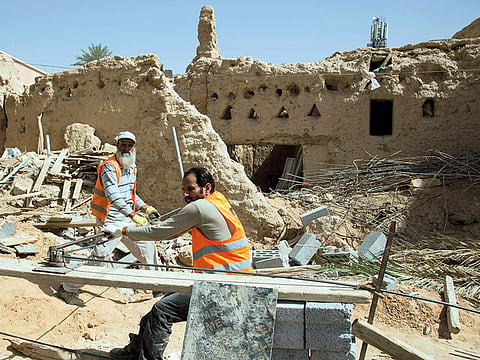Saudi Arabia to attract tourists to ancient site
Hopes to alter perceptions as it prepares to open country to tourist visas and tour groups

Diriyah, Saudi Arabia: Just outside Riyadh, a group of elementary schoolchildren are on a field trip at Diriyah, where engineers and construction workers are busy restoring a 17th-century fortress, mosques and clay-coloured structures that were once the ruling family’s seat of power.
The Unesco World Heritage site lies in a conservative, arid patch of the country and is unlikely to feature high on any bucket lists for world travellers, but the kingdom is hoping to alter perceptions as it prepares to open the country to tourist visas and international tour groups later this year.
Diriyah lies at the heart of Saudi Arabia’s efforts to both control the narrative of its past for future generations of Saudis and to revamp its image to curious world travellers.
It’s an especially important site to the ruling Al Saud family because it’s here where the first Saudi dynasty was founded in the 15th century. The architecture here is associated with the tribes of Najd, the landlocked region in the heart of the Arabian Peninsula that is now home to Riyadh and surrounding cities.
In the 18th century, Diriyah rose to become once again the centre of power for the Al Saud, but fell under Ottoman control in the early 19th century. It would take more than a century for the Al Sauds to reclaim Diriyah and found the current Saudi state- named after its ruling family.
Today, much of Diriyah remains closed to the public as authorities work to restore it to its former glory — except this time fitted with the modern comforts of air conditioning and plumbing. The area around the fortress resembles a modern desert oasis with palm trees, parks, restaurants and coffee shops, drawing young Saudis and families in the cooler months looking for green, open spaces away from the congested streets of Riyadh.
“There is an amazing amount of history here,” said Chris Brooks, who frequently comes to Riyadh on business. With a few hours to spare between meetings, he decided to visit Diriyah and take some photos to share with his family back in the UK.
Still, it’s not a place he’d encourage his family to visit just yet.
“It’s going to take some convincing families to want to come here,” he said. “To open up, you need it to be more welcoming, more accessible. It takes a lot of time to get a visa to come here and if they address those issues then I think, yeah, more people will come here. There is just so much to see.”
For Crown Prince Mohammad Bin Salman, Diriyah is part of a much larger national project to overhaul the country’s economy and make it more resilient in the face of lower oil prices. Boosting domestic spending and opening the country to foreign tourists are seen as ways to create more jobs for the millions of young Saudis who will be entering the workforce and looking for jobs in the coming years.
The religiously conservative country ran a pilot programme between 2006 and 2010 welcoming around 25,000 visitors annually to see Saudi Arabia’s ancient archaeological sites and vast landscapes of mountains, coastline, valleys, volcanoes and deserts.
Saudi Arabia boasts regions where ancient Christian and Jewish communities once thrived, historic forts, a stunning Red Sea coastline and a diverse culture moulded by ancient trade and pilgrimage routes.
Tourism official Salah Al Taleb, who’s overseeing investments in the tourism sector, said visits to sites like Diriyah will help tourists “correct” the image they may have of Saudi Arabia.
“Once they come here and see the country, I think the marketing literature tells us that they would go back and tell their family and friends and relatives about what they experienced and things will start to change then,” he said.
Sign up for the Daily Briefing
Get the latest news and updates straight to your inbox


![An aerial view shows Kingdom Tower in the Saudi capital Riyadh. [Illustrative image]](http://media.assettype.com/gulfnews%2Fimport%2F2020%2F05%2F26%2FSaudi-Riyadh_172500ec388_large.jpg?w=320&auto=format%2Ccompress&fit=max)
